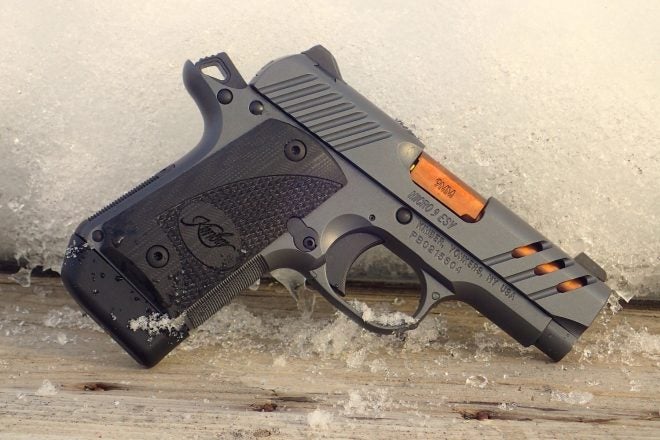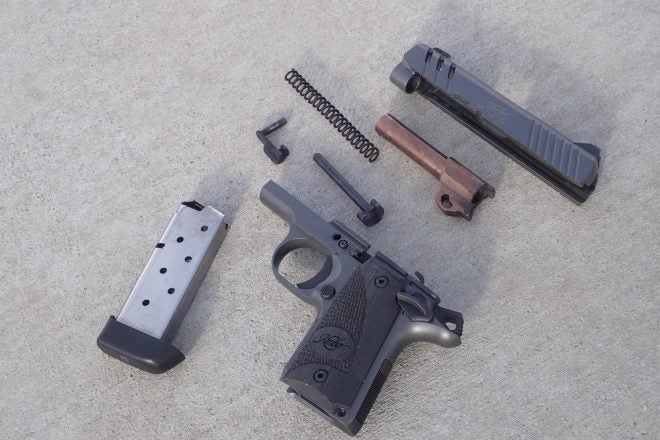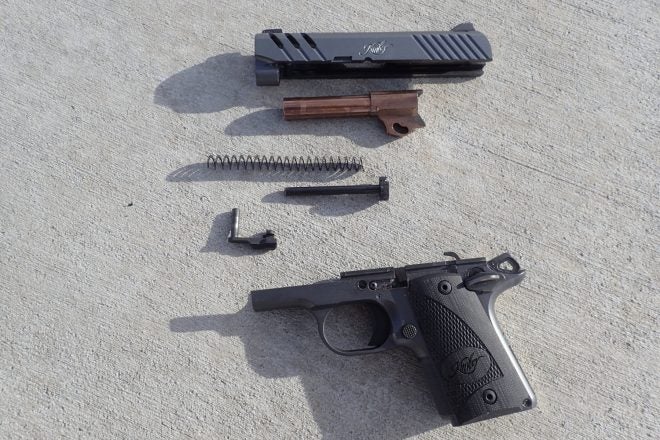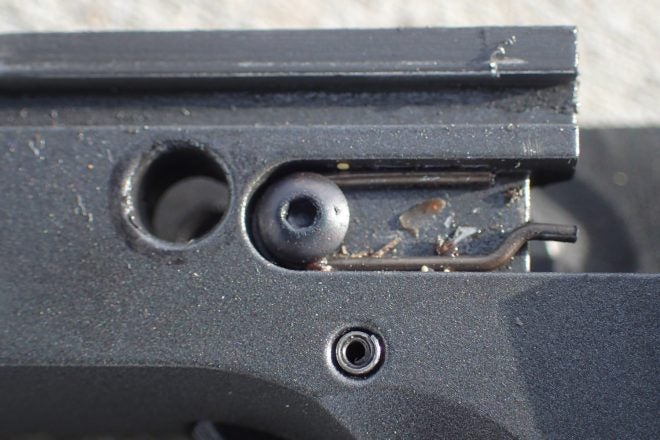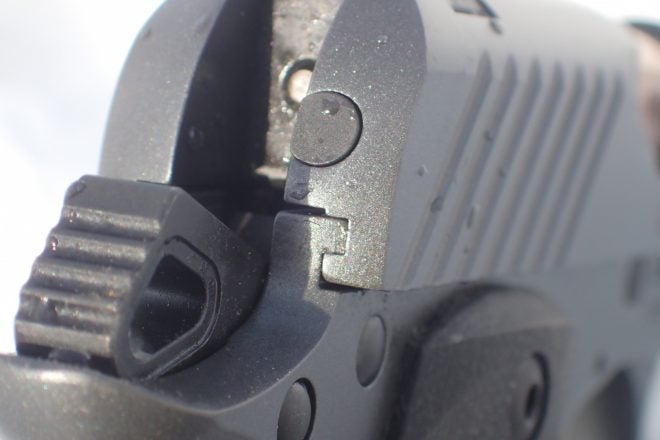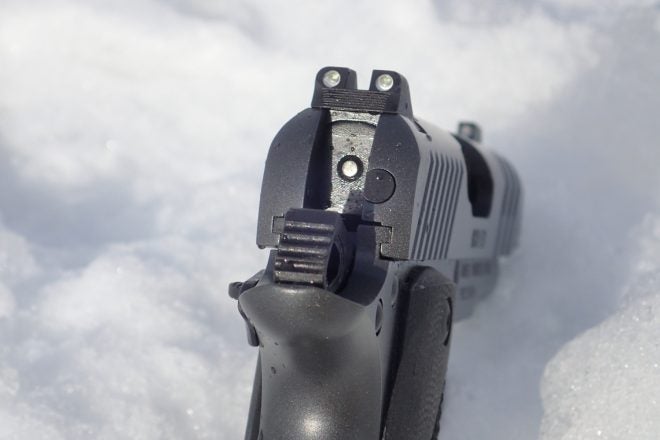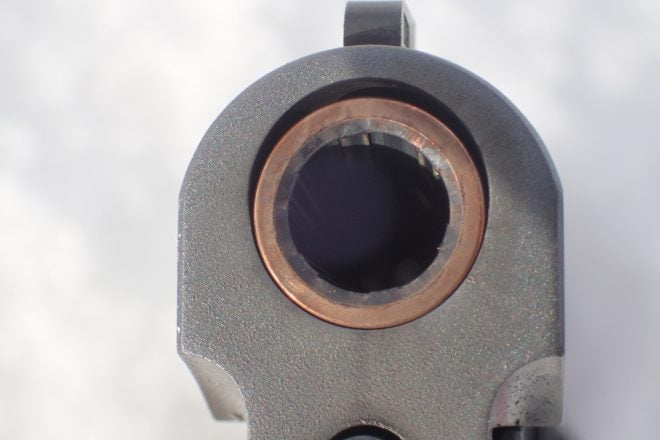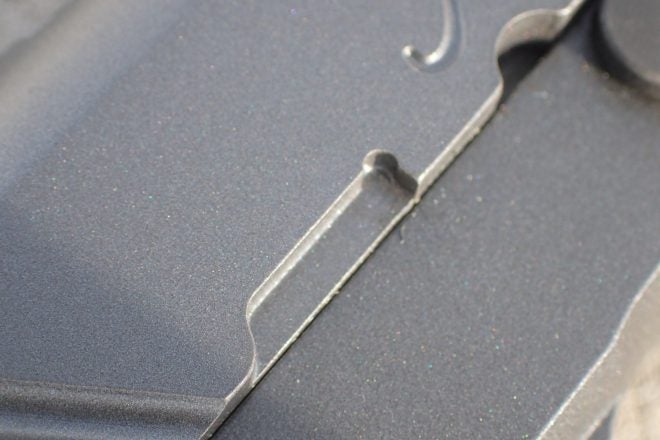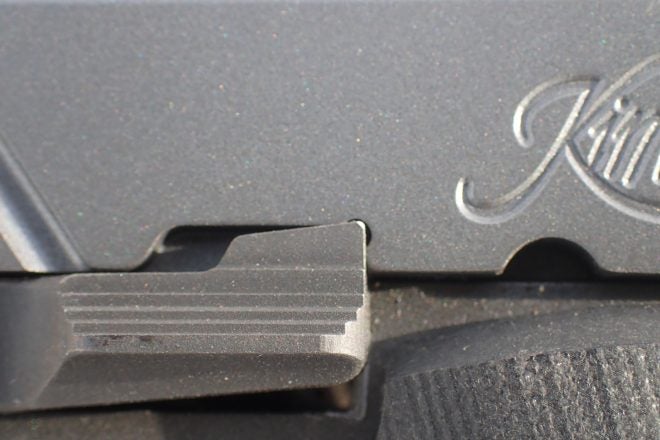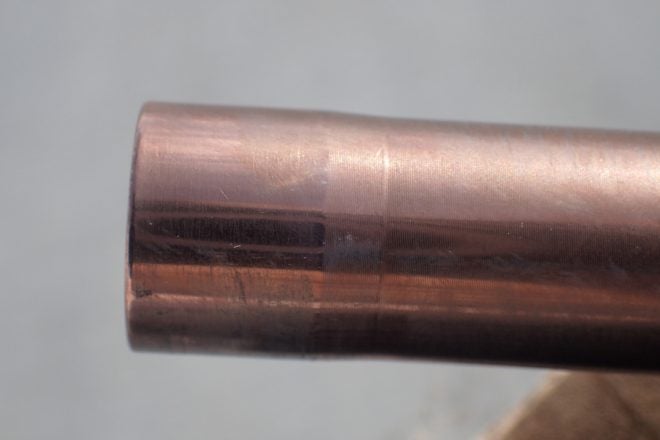A tiny 9
The new Kimber Micro 9 ESV is one of the latest additions to Kimber’s Micro 9 line of pistols. Like other Micro 9’s, the ESV has a steel slide and aluminum frame, and is an upscaled version of their Micro chambered in .380. The unique features of the ESV are:
- Night sights
- Kimpro II finish in grey or black (this test model is in grey)
- Altamont G10 Grips
- Slide porting
- Ball mill cocking serrations
- Rose Copper coated barrel “for increased corrosion resistance”
This brings the array of Micro 9’s to Nineteen. With so many options to choose from, should you be looking for a Mustang-type platform in 9mm, Kimber has the looks and options department pretty well covered. When it comes to subcompact handguns, some consumers only care about utility, but a firearm that looks nice as well doesn’t hurt. This particular platform is an area of fierce competition as well, with comparable entries from Springfield and Sig Sauer. Good looks may be one thing, but these pistols need to make a good showing on the range as to inspire confidence for the concealed EDC role they are clearly meant for.
Specs (Per Kimber):
Specifications
- Height (inches): 4.0
- Weight (ounces) with empty magazine: 15.35
- Length (inches): 6.1
- Width (inches): 1.08
- Magazine capacity: 7
- Recoil spring (pounds): 16.0
Frame
- Material: Aluminum
- Finish: Kimpro II Gray
Slide
- Material: Stainless steel
- Finish: Kimpro II Gray
Barrel
- Length (inches): 3.15
- Material: Stainless steel, match grade
- Twist rate (left hand): 16
- Coated in Rose Copper
Sights
- Standard Night Sights
Grips
- Altamont, G10, Black, Machine Checkered, Kimber Logo
Trigger
- Premium aluminum
- Factory setting (approximate pounds): 7.0
MSRP: $799.00
Extra Magazines: $34.95 for 7 round extended, $32.95 for 6 round flush fit.
Initial impressions:
Upon unboxing the Kimber Micro 9 ESV, I noted it ships zipped in a branded pistol rug. This strikes me as a strange use of resources. A consumer would gain far more utility if Kimber shipped these with an IWB or pocket holster. This is, after all, a gun designed to be carried, not stored as a safe queen. The size and weight of the Micro 9 ESV are diminutive for a 9mm. At 15.35oz unloaded, it weighs less than the plastic framed Glock 43 or Ruger LC9, though the Kimber has an aluminum frame. It conceals very easily either IWB or in a non-printing pocket holster.
The grey Kimpro II finish, slide cuts, and rose copper coated barrel certainly make the looks of this pistol stand out. While the slide cuts may reduce weight a bit, they also are an avenue of encroachment for dirt, rain and snow. The fit and finish of the pistol are very good. Slide to frame fit was very precise (This is often what I will look at in my initial assessment of a firearm’s build quality) and the slide was easy enough to rack. Another positive aspect of the finish: Kimber’s Micro 9s feature aluminum triggers, while some competitors in this platform use plastic.
The safety clicked positively into both on and off positions. Of the roughly 10 subcompact pistols equipped with manual safeties that I’ve fired, the Kimber Micro 9’s was the easiest to deactivate during the drawstroke. The tritium night sights are outlined in white and stand out well. On such a short slide, there is hardly any visible gap between the front and rear sights when held at arm’s length.
- Broken down for cleaning, The slide stop pin is very hard to push out from the frame under field conditions.
- note the raised ejector in the frame, forward of the hammer. This must be pushed down out of the way upon reassembly.
- View of the slide stop spring held in place on the frame by a screw
- Good slide to frame fit
- Night sights
- The barrel does not fill the front opening of the slide, but rests on the bottom.
- slide cut for slide stop
- slide stop at work
- Bullnose of the barrel
The ESV, like all Micro 9 pistols, also ships with one 7 round extended magazine. As a former firearms retailer, I can understand Kimber’s decision to keep costs down by shipping only one magazine, and generally, retailers realize better margins on accessories (like magazines) than firearms. This cost-cutting can cut both ways, however. Sometimes it can be hard to sell an EDC oriented firearm that only comes with one magazine. Potential customers should be aware that they are going to need to purchase a mag should they be wise enough to carry at least one extra.
At the range:
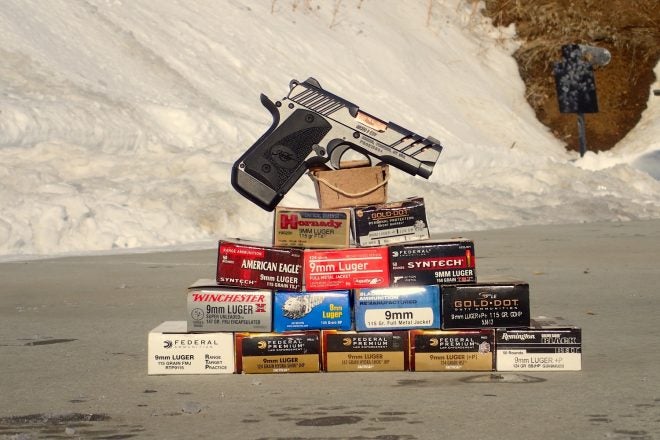
The Kimber Micro 9 ESV handled a wide selection of ammunition just fine reliability-wise, though had clear preferences when it came to accuracyEquipped with the ESV, a suitable IWB holster and 14 different loads of 9mm, I headed to the range. Before sending metal downrange, I took the time to do some dry practice. The Micro 9 ESV, though being suitable for pocket carry, lends itself well to being drawn out of an IWB holster as well. I did not have any issues in getting my hands to positively grip the gun during a draw stroke. The rounded trigger guard was barely large enough to accommodate my fingers when wearing light gloves and would preclude the use of heavy gloves.
Dry practice with the trigger gave me further confidence in the ESV. As per usual in this platform, it is a pivoting SAO trigger, attached to a single trigger bar. The trigger pull weight averaged 7 lbs 1oz but felt lighter. The break was legitimately crisp, with very little pre-travel, and the reset was short and precise.
I did notice when reholstering that the Micro 9’s slide has a tendency to slide back out of battery. The safety being engaged does not prevent this movement either. One will have to be very conscious of this trait if carrying this pistol. The easy movement of the slide does lend itself well to one-handed racking by using the friction of the rear sights against one’s belt or pocket, however.
Shootability and Reliability:
The 7 round extended magazine was easy enough to load. Firing at an array of seven 5″ plates staggered in a V formation from 5-15 yards, I was able to hit all 7 rounds in a row fairly quickly. Double taps are easy to accomplish with the Micro 9, and the white outlined tritium sights lend themselves well to being picked up quickly upon drawing the firearm. While the magazine dropped free with each press of the release, I cannot comment on the ESV’s ability to be quickly reloaded as I only had one mag to work with.
Transitioning over to some paper targets and my large variety of ammo, I began to notice some idiosyncrasies of the Micro 9. There is not a lot of real estate on the grip of the Micro 9. When firing +P or +P+ loads, I had to be very conscious not to have my thumb near the magazine release button on the left-hand side of the frame. Under recoil, the slightest contact with the button would eject the magazine, causing various cycling malfunctions. I needed to adjust thumb placement, and unfortunately, the only other place to put it was in contact with the slide release. Once I adjusted my grip, these malfunctions no longer occurred, but sometimes my thumb would release the slide on an empty magazine.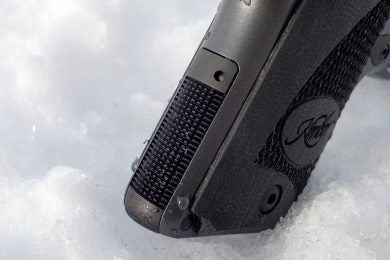
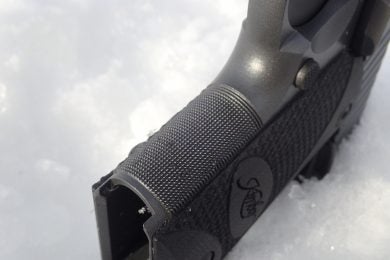
The front and rear checkering helped provide positive control over its small size
The Micro 9 ESV churned through the 14 different pressures, profiles, and cases without any initial issues. Only after round 385 did I have two FTCs, one with a Speer Gold Dot HP hanging up on the rather dirty feed ramp, and another with the slide not going fully back into battery. Around the same round count, I also experienced one FTE. Overall, I had three non-user caused malfunctions in 400 rounds, all after round 385. I did not clean the ESV at all during testing except for snaking the barrel when changing ammo during accuracy testing.
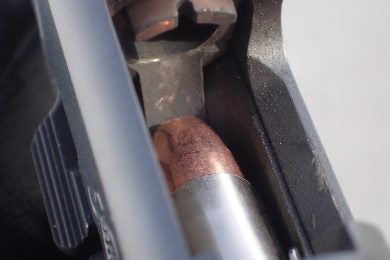
The cause of FTC#1
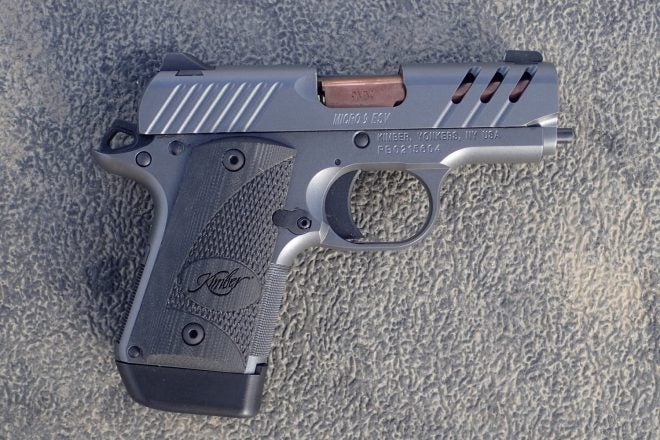
FTC #2 in which the firearm did not go fully back into battery.
Accuracy:
I tested the Micro 9 ESV with 13 loads, shot offhand at a range of 15 yards. Results are the average of three 5 shot groups, measured center-center, listed in order of accuracy.
- Federal Syntech 150gr TSJ (SWC): .78″
- Silver Bear 145gr FMJ: 1.29″
- Federal RTP 115gr FMJ: 1.48″
- Speer Gold Dot 115gr +P+: 1.63″
- Remington Golden Saber Black Belt 124gr JHP +P: 1.69″
- Winchester 147gr FMJ: 1.88″
- Federal Hydrashok 147gr JHP: 1.94″
- Speer Gold Dot Short Barrel 124gr +P: 2.15″
- Federal Hydrashok HST 124gr +P: 2.21″
- Aguila 124gr FMJ: 2.42″
- Hornady 115gr FTX: 2.52″
- Federal Hydrashok 124gr JHP: 2.75″
- American Eagle Syntech 115 TSJ: 3.15″
For practical accuracy testing, I fired three “failure drills” from a holster at an IPSC silhouette target at distances from 2.5-25 yards in 2.5-yard increments. Hits were consistently in the “A” zones until 17.5 yards, when rounds started showing a proclivity to the left. I made sure this was not due to recoil anticipation or using too little trigger finger. I had two other shooters, one a professional instructor and the other an accomplished USPSA competitor try the ESV out with the same result. This led me to conclude that either the sights needed to be drifted slightly, or there was a stabilization issue with the RTP 115gr at those ranges.
Overall Impressions:
Objectively, the Kimber Micro 9 ESV is a very compact and concealable 9mm that is also rather lightweight. It demonstrated reasonable reliability with a very wide range of ammunition. It is not a precision firearm, and careful load selection is essential to get as much accuracy as possible out of the platform.
Subjectively, I have mixed feelings about the Micro 9 ESV. I do prefer 1911-profile firearms and SAO triggers, so that feature set worked well for me. The ESV drew and pointed very naturally for me as well. Having handled the Springfield 911 and Sig P938, the Kimber looked and felt the best made of the three popular choices in this caliber and platform, and seems priced right for its feature set.
On the other hand, the slide movement on reholstering bothered me quite a bit. I also feel its magazine release may be oversensitive. The exclusion of an extra magazine and selection of a zippered pistol rug instead of a holster also seem like odd choices.
Overall, I would say the Micro 9 ESV would be a solid choice if one wants an all metal, yet lightweight and ultra-compact 9mm that has a single action trigger, exposed hammer and comes with night sights and a manual safety.
Pros:
- Consistent and Crisp trigger
- Easily concealable IWB or in a pocket holster
- Good fit and finish
- Lightweight
- Can run well with many different loads
Cons:
- Comes with only one magazine
- The slide can move out of battery when reholstered
- Hard to disassemble in the field
For more information, please visit Kimber America.
Thanks to Hughston Shooting School for range time and logistic support
 Your Privacy Choices
Your Privacy Choices
